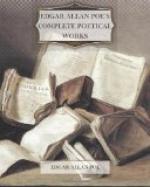Poe worked hard at the ‘Gentleman’s’ for some time, contributing to its columns much of his best work; ultimately, however, he came to loggerheads with its proprietor, Burton, who disposed of the magazine to a Mr. Graham, a rival publisher. At this period Poe collected into two volumes, and got them published as ’Tales of the Grotesque and Arabesques’, twenty-five of his stories, but he never received any remuneration, save a few copies of the volumes, for the work. For some time the poet strove most earnestly to start a magazine of his own, but all his efforts failed owing to his want of capital.
The purchaser of Burton’s magazine, having amalgamated it with another, issued the two under the title of ‘Graham’s Magazine’. Poe became a contributor to the new venture, and in November of the year 1840 consented to assume the post of editor.
Under Poe’s management, assisted by the liberality of Mr. Graham, ‘Graham’s Magazine’ became a grand success. To its pages Poe contributed some of his finest and most popular tales, and attracted to the publication the pens of many of the best contemporary authors. The public was not slow in showing its appreciation of ‘pabulum’ put before it, and, so its directors averred, in less than two years the circulation rose from five to fifty-two thousand copies.
A great deal of this success was due to Poe’s weird and wonderful stories; still more, perhaps, to his trenchant critiques and his startling theories anent cryptology. As regards the tales now issued in ‘Graham’s’, attention may especially be drawn to the world-famed “Murders in the Rue Morgue,” the first of a series—’"une espece de trilogie,"’ as Baudelaire styles them—illustrative of an analytic phase of Poe’s peculiar mind. This ‘trilogie’ of tales, of which the later two were “The Purloined Letter” and “The Mystery of Marie Roget,” was avowedly written to prove the capability of solving the puzzling riddles of life by identifying another person’s mind by our own. By trying to follow the processes by which a person would reason out a certain thing, Poe propounded the theory that another person might ultimately arrive, as it were, at that person’s conclusions, indeed, penetrate the innermost arcanum of his brain and read his most secret thoughts. Whilst the public was still pondering over the startling proposition, and enjoying perusal of its apparent proofs, Poe still further increased his popularity and drew attention to his works by putting forward the attractive but less dangerous theorem that “human ingenuity could not construct a cipher which human ingenuity could not solve.”
This cryptographic assertion was made in connection with what the public deemed a challenge, and Poe was inundated with ciphers more or less abstruse, demanding solution. In the correspondence which ensued in ‘Graham’s Magazine’ and other publications, Poe was universally acknowledged to have proved his case, so far as his own personal ability to unriddle such mysteries was concerned. Although he had never offered to undertake such a task, he triumphantly solved every cryptogram sent to him, with one exception, and that exception he proved conclusively was only an imposture, for which no solution was possible.




